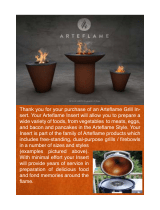
GRILL USE
CERAMIC RODS
The layer of ceramic rods, under the grH[ racks, wi[[ last for many years with proper care. They are
shipped from the factor}, pre-assemb[ed on the radiant tray, read}, to be set in place into the fire box,
under the grH[ racks. Be sure to remove an}, packaging material from the radiant tray and rods before
using the grill Burned food partk[es and ash can be emptied off the radiant tray when coo[ by
shaking over a waste receptacle. Chipping or cracking of the ceramic rods may occur as they may get
brittle with age, depending on frequency of use. This is normal and does not affect the cooking. Do
not replace the radiant tray/ceramic rods with alternates. Contact DCS for genuine factory-direct
replacement parts.
USEOF THE GRILL
Before starting to cook on the grH[, be sure the drip tray and [iners are in pHaceand that you have the
grH[ racks turned to the side you want for cooking. Preheat the grH[ for 10 minutes with the contro[
knob set on HL When the grH[ is preheated, turn the knob down to medium to How,place the food on
the grill. Cook it to the aloneness desired. During cooking, it may be necessary to adjust the heat
setting. The control knob may be set to any position between HI and LO. For proper searing and
browning, the grill requires high to medium heat. When cooking, you will use medium to low heat the
entire cooking time. With large pieces of meat or poultry, you may need to turn the heat to low setting
after the food has been seared. This lower heat setting will allow the food to cook through without
burning the outside. When using a sugary marinade or barbecue sauce, it may be necessary to turn
the heat setting down near the end of the cooking time. Do not leave the grill unattended while it is
turned on. When you are finished cooking, allow the grill and the drip trays to cool before cleaning
them. They should be cleaned each time they are used.
NOTE: The Ionger you preheat the grill, the darker the grifl marks.
EXCESSIVE FLARE UPS AND FLAMING
Occasionally grease drippings ignite. These drippings will create minor puffs of flame for a second or
two. This is normal when cooking on a grill. You may find it handy to have a spray bottle filled with
water to lightly spray the flare-up. If the flame becomes excessive, remove the food from the grill.
Lower the heat setting. Replace the food when the flare-up subsides. To prevent flare-ups from
happening, trim the fat from around the edges of steaks and chops, use hamburger that is lean,
remove the fat that is on poultry, etc. When turning any kind of meat or poultry, the melted fat will
drop onto the ceramic rods and it may create a flare-up. If this happens, use a long handled spatula to
move the food to another area.
GRILLING HINTS
The doneness of meat is affected by the thickness of the cut. It is impossible to cook a thin piece of
meat to a rare doneness. A steak should be at least 1-inch thick to have it turn out rare and juicy.The
cooking time is affected by the temperature of the meat when you start to cook it, the size and shape
of the cut and the kind of meat you are cooking. The degree of aloneness desired also affects the time.
When turning the meat over, always use a spatula or tongs as it wi[[ not puncture the meat allowing
the juices to run out, This will help to keep the meat iuicy, Turn the meat only once, as juices are lost
when the meat is repeatedly turned, Be sure to trim any excess fat from meat or poultry, To prevent
steaks or chops from curling while they are being cooked, slit the fat around the edges at about 2-inch
intervals, To test for doneness, make a small cut in the center of the meat,
14




















